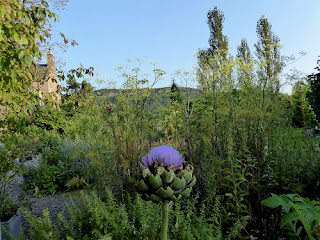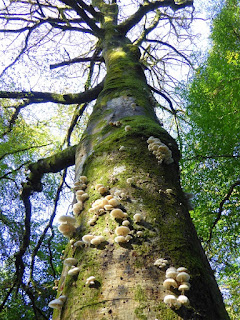Given the extraordinary circumstances which delivered two separate bouts of hot sunny weather in Scotland, I managed to hit cold natural waters inland on three occasions: the Tweed where it's joined by Biggar Water,
the Tay at Newburgh
and the the Lemahamish Pool where the waters of the Forth between Gartmore and Aberfoyle become temporarily more tranquil.
The first two river plunges happened on visits to friends in Broughton (between Peebles and Biggar)
and Abernethy (near Perth)
after a short bout of Edinburgh Festival going. On the day before the plunge I walked part of the Buchan Way with old university friend Christopher, partner Ruth accompanied by dog Lily, and C's son (my godson) Alexander. Leaving behind a very lively hillrunning event, we headed up between the heather-clad hills - Wales is losing its heather, Scotland could be threatened by global warming too anon -
and down another valley before branching off the main route towards the reservoir at the Stobo Estate
where we stopped for a picnic lunch
before heading down to the water gardens. The next morning Alexander drove us over to Biggar to see his first home with girlfriend Kirsty, and we saw yellow-dyed prize sheep in a field, ready for the big show the following week,
before heading out to near Ruth's for the bathing place. She has a wonderful view over the broad valley of the Tweed between Peebles and Biggar
and it doesn't become any the less beautiful the closer you get to the water.
Ruth was first in, keenly watched by Lily and a quickly-made pal in the form of a passing pet.
Negotiating a muddy start, we were quickly in, accustomed ourselves to the cold and sat in the sun for a bit on the pebble bank opposite before swimming back. I was the last out, and Lily decided to come and join me for a second splashabout before beating me to the shore, as you can see from the photo up top.
Next to the idyllic home of Caroline and Alan near Abernethy, itself not far from a river - the Earn - along which the Fife Coast Path should continue to Perth, but an old farmer who now has dementia wouldn't allow it on his land. So we drove to St Andrew's alongside the Tay, which the Earn quickly joins, and stopped at Newburgh for a walk through the reedbeds - the largest in Europe, it's said, a fine reserve for many birds -
to a small beach used for launching boats. The current looked strong not far out, but I ventured it, found it all pleasant, and came back after a good few minutes.
We spent rather too long wandering round St Andrew's in the heat, looking for a good place to take Caroline to lunch to thank her for her hospitality. As we were about to cave in to an unpromising hotel restaurant, a chance venture down the dip towards the beach revealed The Seafood Ristorante, its big glass windows overlooking the bay. As we were late by lunch standards, a table wasn't a problem - and it was worth it: top marks for both starter and main course.
Lingering meant a brisk walk back to the car, where time was just up on the metre.
We were also eating well Chez Caroline each night, when it was warm enough to sit in the pavilion at the end of the pond. Alas, I never did see the hares which frequent the area behind it - one of the babies was killed by a buzzard after we left - but early morning and sunset walks around the garden rooms were such a joy.
The Lemahamish Pool of the Forth I only discovered on the last of my full days holding 13 sessions on Die Walküre over the weekend for the Wagner Society of Scotland. More on those anon, but in my two hours free each afternoon I never got as far as Abernethy. But I did manage to hit the cycle path, which turned out to be on the wrong side of the river to access bathing (here, the views both ways from the bridge).
So I went to the HQ of the campsite on the other side, and they told me it was fine to walk through the site and then take a path past a small waterfall
to the very pleasant green and beach beyond. Wasn't sure that was it when I saw it,
but a couple out walking their dog assured me it was, that the water level was very low but still deep enough to swim - as their dog was doing. So in the break between the rains of that last day I took the coldest dip of the year to date.
I wasn't submerged for long, but I did it. And then, after the few rays of sun, it started to rain again. The route from grand Gartmore House where we Wagnerites were all lodged was an especially lovely one - down the drive to the (privately owned) pool near the bottom of the hill, glorious in both the hot sunny weather of the first two days
and the onset of autumn that Sunday,
and along Butler's Path, one of the loveliest woodland walks I know.
Last year was especially rich in fungi, because it had rained a lot and continued to do so while I was there, but at least this year the tree with mushrooms rather than bracket fungi springing from it looked good in the dappled shade. With a bit of help, I've been able to identify the species as porcelain fungus, Oudemansiella mucida.
The only loss that rainy Sunday was the chain of cobwebs which had looked so lovely in the sun on the Saturday.
I never did get as far as the hills, but at least I could see them. Next September I must take some extra days around Siegfried to explore the area.
More hermetically sealed than Gartmore House was the oasis of Tsinandali in the wine-growing Kakheti region of Georgia, where as the rivers in the valley were all dry my dip happened to be in an exquisite rooftop pool of the Radisson Blu Hotel, connected to the two concert halls - indoor and open - where the festival events I was attending took place. On those, and a wonderful monastery not far from the grounds, more anon here and on The Arts Desk.





















































































